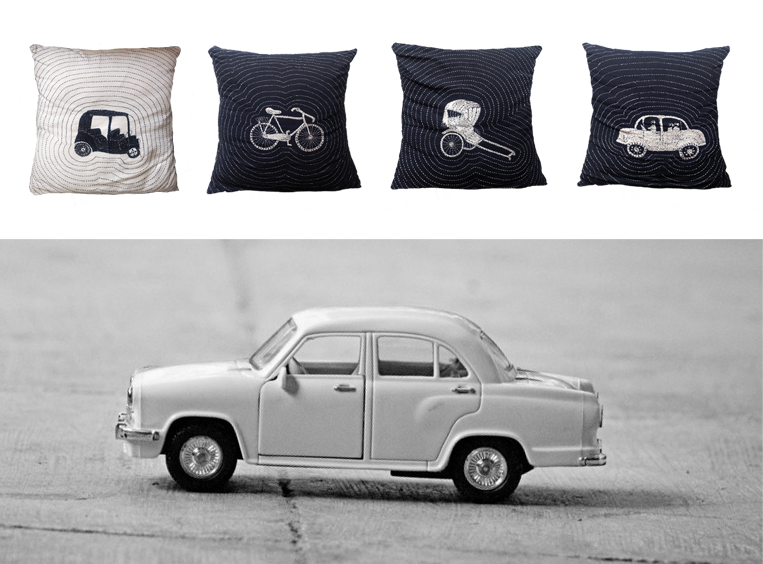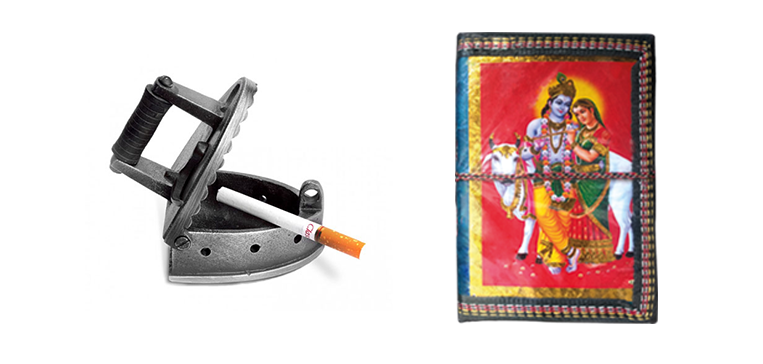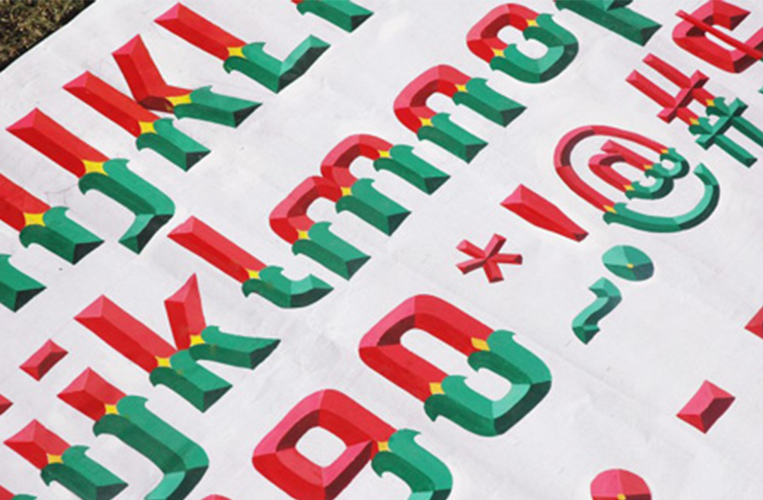A Class Apart
A drawing room sofa upholstered with bold graphics runs the risk of showing poor taste. But sofa cushions, by convention, are a license for graphic fun. My sofa set sports a smart black and white set (pictured) of four, with printed and crudely embroidered naive drawings.
They picture: a bicycle; a hand pulled rickshaw; an Ambassador car; and, that most beloved of urban symbols, a three-wheeled scooter rickshaw (TSR in sarkari bhasha; to some foreign tourists, a tuk-tuk). Visitors usually register them with micro-smiles, given with faintly amused approval and without comment.

Cushion covers—a bicycle; a hand pulled rickshaw; an Ambassador car; and a three-wheeler scooter rickshaw
Deep Design settles into the soft cushions and runs a speculative eye on the road travelled by these variously-wheeled vehicles. How did these objects of everyday utility turn into what we may call figures of fun?
Visit an appropriately tony gift shop and note that these images are commonplace, reprised repeatedly by designers, named or anonymous. The bicycle is a popular street toy in wire. The Amby, as the Ambassador is affectionately known, appears as a toy, has served as muse to many nameless designers, also to eminent photographer Raghubir Singh who shot a documentary book around it, and celebrated contemporary sculptor Subodh Gupta who cast one in metal. (Gupta’s work frequently references quotidian objects, revealing a grotesque comedy of class manners). The TSR is a curio favourite, and the illustrator’s pet.
There are more such: the little bronze miniatures of coal-heated irons, the massive istri your presswala (the Delhi term for ironing man) flattens your clothes with (pictured); the ‘bhopu’ or air claxon that served as a horn on the TSR long after cars went entirely electric.

(L-R) Beloved urban symbols; an ‘istri’ miniature as ashtray, god pictures on notebooks
The ubiquity of these images, and the certitude of their interpretation, is the reason that my typical guest gets the image, without comment. You could say these images are in the ‘popular culture’ (itself a pop-culture term) except that the term ‘popular’ assumes that we know who is or isn’t included.
An American, as a first time visitor, for example, would not warm to the TSR or the Ambassador in the way ‘we’ do. Without the shared reference, the image does not travel from us to him in the manner it travels amongst ourselves. This sort of generally westernised, English-speaking Indian visitors to my drawing room can be expected the access the encoded meaning of the images; the American cannot. We say that these images form an index, a code that is shared by a specific group.
But shared reference is not enough to enter an object in the index; nor is the property of antiqueness, or ordinariness, sufficient. A Honda car may feature as a toy car, but has zero status as an image for consumption.
To be indexed for enjoyment, the property that an image/object needs is what I call distance, a degree of separation from the object, so that it is taken out of our every day, our present. Thus, the TSR driver and the ironing man cannot be expected to share in our jollity on their everyday tools being picturised, as innocent, glorious or fun.
The meaning is created not by the shared reference of the coal iron or TSR as objects, but by the distance from them, shared by members of a class that is characterising the other. By imaging and framing these objects, a class further distances and separates itself from the other (in this example, the dhobi and rickshawala class) by emphasising the object’s foreign-ness, and viewing it with an ironic, if affectionate gaze.
a class further distances and separates itself from the other by emphasising the object’s foreign-ness, and viewing it with a ironic, if affectionate gaze.
So the shared meaning is in the gaze, not in the object.
Class is thus a fecund source of image codes. Image and identity make each other. The objects both indicate and sustain a kind of intra-class signalling, making the mundane exotic, and the adjacent foreign. The result is the creation of a vernacular.

Hanif Kureshi Handpainted Type project
Meanings can also be reinforced by members of powerful outside groups. The westerner’s fascination with the TSR signals or reinforces its value; the class that can access and align itself westwards, now finds redoubled enjoyment in it. A kind of inter-class signalling.
Not just objects but styles and aesthetic themes can emerge from class or group signalling. Businesses can appropriate the codes thus created.
Not just objects but styles and aesthetic themes can emerge from class or group signalling. Businesses can appropriate the codes thus created.
In India, we recognise as a kind of kitsch the styles that emerged from Hindi cinema posters, now lost, as we do the swaggering (or swooning) dialogue that we parody. The use of polychrome gods on a notebook as a kind of urban chic (pictured), and the instructional “Ideal Boy Charts” (pictured) that now have meme status depend on this class-located gaze. The ironic enjoyment of these is for those at whom the original images were not aimed, in order: the not-filmy-at heart, the well-schooled, and dare I say it, the ungodly, to whom the notebook might be a mild sacrilege, or attract devotion, not a wink.

(L-R) The instructional ‘Ideal Boy’ charts; Hindi cinema posters
What’s in all of this for design? Design’s first task may well be the creation of better outcomes or adding value to a client situation, but it cannot be left at that. A residual task of design is to contribute to the visual world, leaving it better. We remember whether products were beautiful or ugly long after we took for granted that they worked, or didn’t. To do this, and perhaps even to be effective in her primary task, the designer needs a heightened awareness of how things come to mean something, and especially, to whom.
____________________
First published in a slightly modified form ‘A Class Apart’ in Business Standard, 31 March, in Deep Design, a fortnightly column by Itu Chaudhuri.

